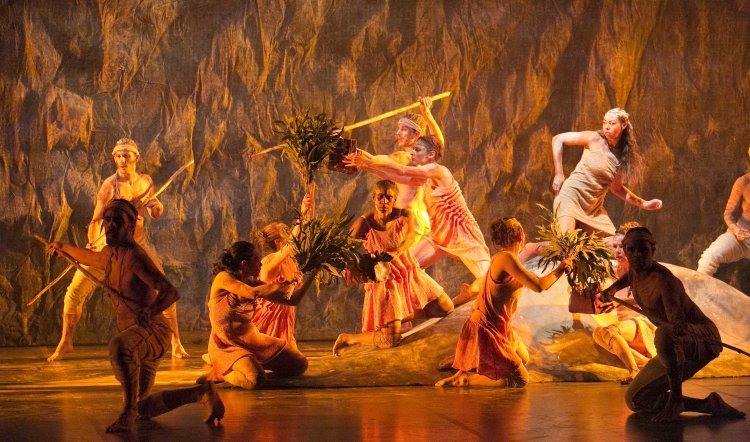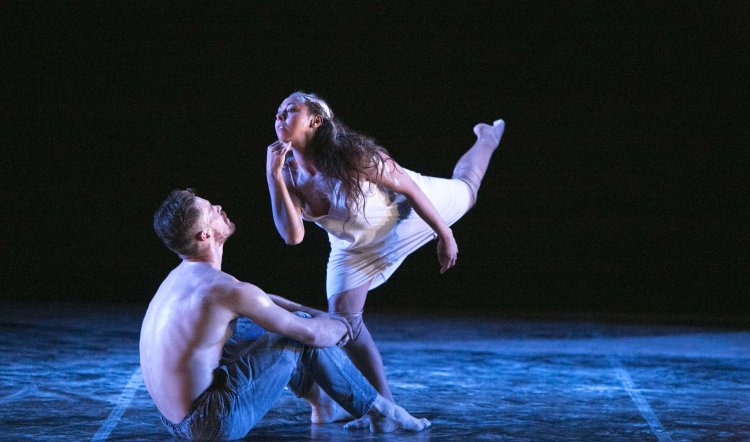
PATYEGARANG
PATYEGARANG, Bangarra Dance Theatre at Sydney Opera House Drama Theatre, June 13 – July 5, 2014. Photography: Jess Bialek, above: Bangarra Dance Theatre’s ensemble; right: Thomas Greenfield and Jasmin Sheppard.
Bangarra Dance Theatre has entered a new era with its latest work Patyegarang.
Not only does it mark the first time Bangarra have tackled a specifically Sydney story, but it’s also the most flawless pairing of contemporary classical dance with Bangarra’s trademark earthy style that I’ve seen from them so far. It’s an absolute triumph.
The story behind it is a fascinating one: Patyegarang was a woman of the Eora nation, the traditional inhabitants of the Sydney basin, who befriended Lieutenant William Dawes (of Dawes Point fame), the colony’s timekeeper. By all accounts, theirs was a meeting of minds rather than bodies (although there’s some indications it was sexual too): Patyegarang taught Dawes the Dharug language and culture, which he recorded in his notebooks, and she acted as a conduit between the settlers and the Eora.
Although their friendship lasted only three months: it was enormously fruitful time: in his diaries, Dawes recorded not only Dharug words but phrases related to personalities, actions and feelings, creating a remarkable picture of Eora culture at the point of first contact with the British colony.
What happened next was equally interesting: the diaries languished in the library of the University of London’s School of Oriental and African Studies until 1972, where they were rediscovered by a Australian librarian. Since then, the story has been retold in various guises, most notably in Kate Grenville’s 2008 novel, The Lieutenant.
Bangarra’s retelling of Patyegarang’s story steers clear of simply recounting the narrative of their friendship, opting instead for a more spiritual interpretation in which fragments of it are told through larger scenes detailing different points of contact: conflict, teaching, intimacy, friendship, sharing of knowledge and so on.

Stephen Page’s flowing choreography brings together the more traditional group scenes of hunting and gathering with the Western aesthetic of Dawes and his fellow settlers beautifully, while retaining Bangarra’s instantly recognisable style.
Jasmin Sheppard brings great depth to the wise-beyond-her-years Patyegarang, and while non-indigenous guest artist Thomas Greenfield as Dawes doesn’t quite possess the lithe grace of the Bangarra dancers, he is adept at conveying Dawes’s struggle between loyalty and duty (Dawes was eventually sent back to England in disgrace after disobeying orders to take part in a punitive expedition against the Aborigines).
One of the great joys of Bangarra’s works is the equal importance given to lighting, sound and stage design in each production. Patyegarang is no exception. Jacob Nash’s subtle set conjures up the ancient sandstone of the Sydney basin with a few contoured swirls of orange and ochre, while David Page’s exquisite soundscape is surely one of his best to date as it moves effortlessly between instrumental, electronic and spoken word elements.
As Stephen Page explains, Patyegarang is one of the few good stories to come out of first contact between settlers and the Eora. Unwittingly, Dawes and Patyegarang held the blueprints to transform Australia’s future.
How different things might have been if they had the chance to use them.



